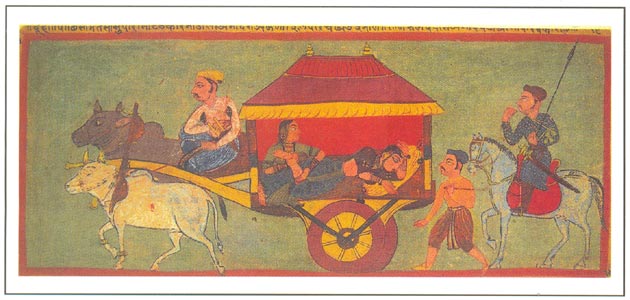 |
|
A folio from the Dhola Maru love-legend of Rajasthan, Mewar, dated 1592 A.D., National Museum, New Delhi |
|
|
Rajasthani Paintings
Rajasthan is one of the pioneer seats of miniature paintings in India. This art form evolved here in Marwar-Mewar region as textual illustrations to the Jain text Kalpa-Sutras around the early 15th century. There reflects in these paintings a continuity of the great traditions of Ajanta murals and Jain art of Gujrat. This initial art style, which manifests in its most evolved form in the Bhagavata paintings rendered at Palam in 1555 and reflects in all subsequent major or minor art styles of Rajasthan, is a blend of indigenous art forms and the elements of the art traditions of Ajanta and Gujarat.
 |
|
A folio from the Dhola Maru love-legend of Rajasthan, Mewar, dated 1592 A.D., National Museum, New Delhi |
Except for some scattered folios of various texts and largely washed murals, Marwar has lost most of its early art heritage. The bulk of miniature paintings that depicts the initial art style of Rajasthan in its most undiluted form, is reported from Mewar. Bold lines, emotionally charged faces, sharp features, robust figures and basic bright colours are its distinctive features. Illustrations to Dhola Maru rendered at Aghatpur, Gita-Gobinda and Rasa Manjari are amongst the earliest known examples of Mewar style. Texts like Rasikapriya, Surasagara, Ramayana, Bihari-Satsai, despite intrusion of Mughal elements, were the dominant themes of Mewar. Painters like Sahibdin and Manohar, using Mughals’ stylistic perfection and the themes of Indian origin, created several timeless masterpieces. In serialising folks like Dhola Maru, Bhakti-ro-patra, Panchakhyano-ro-patra, Bana-bheda-ro-patra, abstractions like Ragamala the Mewar art has the fragrance of its soil.
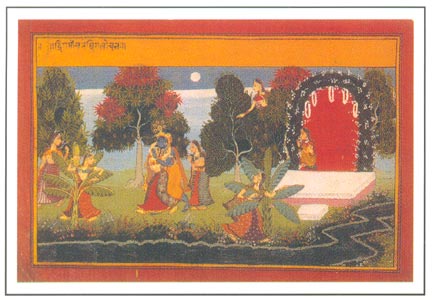 |
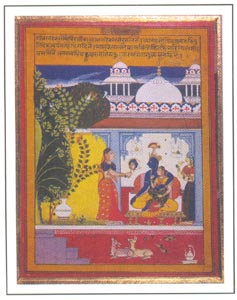 |
|
Radha and Krishna playing blind man buff, Mewar, dated 1719 A.D., National Museum, New Delhi |
Radha and Krishna admiring each other in a mirror, Mewar, circa 1640 A.D., National Museum, New Delhi |
There developed at Shahpura, Pratapgarh, Deogarh and Nathdwara sub-centres of Mewar art. Shahpura and Pratapgarh excelled in royal portraits, Deogarh in variety of themes and Nathdwara in representations of Shrinathji. Nathdwara used a variety of mediums but it surpassed all in its large size cloth wall-hangings, known as 'Pichhawais'.
The first set of Bundi miniatures, a depiction of Indian Ragas, was painted at Chunar. Bundi excelled in its illustrations of Krishna-Lila and Rasikapriya. The blend of Mughal and Deccani art elements in Bundi style is unique. Ragamala illustrations, legends like Laila Mujnun, historical events and scenes of the harem and village life are favourite themes of Bundi. Fine colour combinations, compositional unity, delicate line-work, manipulation of diverse elements, a blend of ‘real’ and ‘imagined’, vibrant landscapes and a strange power to drag the mind impart to Bundi its stylistic distinction.
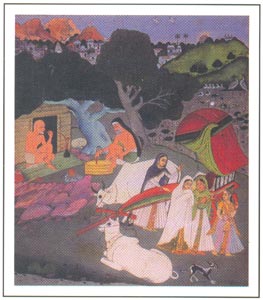 |
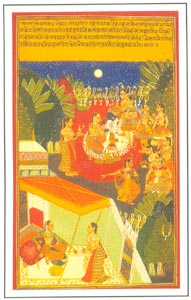 |
|
Visit to a Faqir's Hermitage, Bundi-Kotah, circa 1750 A.D., National Museum, New Delhi |
Krishna enjoying the dance of gopis, Bundi, circa 1700 A.D., National Museum, New Delhi |
Kotah's favourite themes are Rama-Katha, Krishnalila, Mahabharata and other Vaishnava themes. In unity of theme and style, contrasts and balance and well reconciled diversities, Kotah is influenced by Bundi, but Kotah excels Bundi in depiction of themes like Baramasa, festivals, hunting, wild life and vibrant nature consisting of trees waving like a rivulet. Its depiction of beauty, charm and various emotional situations are highly sensuous. Kotah miniatures are exceptionally innovative in portraiture, court and harem life.
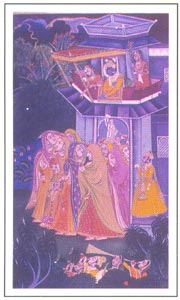 |
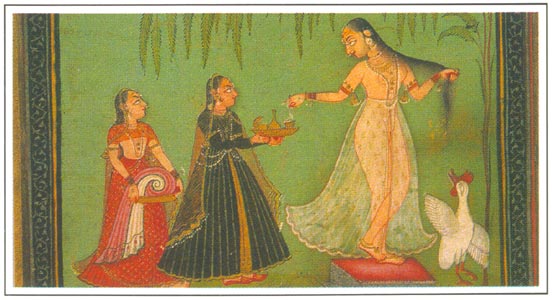 |
|
Gangaur festival, Kotah, circa 1770 A.D., National Museum, New Delhi |
Solah Shringar - Adornment, Kotah, circa 1770 A.D., National Museum, New Delhi |
Uniara, a sub-school of Kotah, is excellent in clubbing various festivals with conventional themes like Baramasa and in the depiction of Ragas and various myths. Indergarh, another Kotah sub-school, preferred portraits.
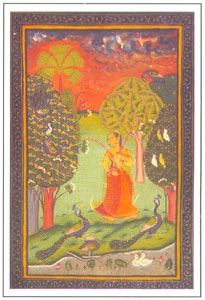 |
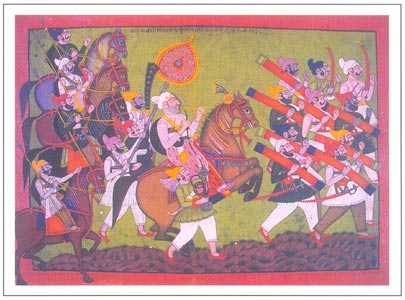 |
|
Ragini Kakubha, Uniara, circa 1770 A.D., National Museum, New Delhi |
Raja Sunman Singh of Indergarh, Indergarh, circa 1770 A.D., National Museum, New Delhi |
Bikaner style is predominated by Mughal elements. It is partly because most of its master artists, Ali Raza, Ustad Sahibdin, Rukunudin, Nuruddin and Murad, had come from the Mughal world and were adept in the Mughal style. But, despite, in its themes Bikaner always inclined to Hindu myths and legends like Krishna-Lila, Ramayana, Bhagavata, Devi-Mahatmya and Ragamala. Depictions of village life, Baramasa, festivals, processions, hunting and the like also have an indigenous touch. Perfect technical execution, maturity of form, elegance and soft colour effects, the widely known 'neem-kalam', is in contrast to Rajasthan's bright deep tones, characterised Bikaner miniatures.
Jodhpur inherited the art tradition of prior Marwar, which Pali, its sub-centre, revived in early 17th century in its Ragamala paintings. The initial idiom of Marwar art style defines these Pali paintings. This Pali idiom was replaced by Mughal elements in subsequent Jodhpur Ragamala paintings. Jodhpur excelled in the depiction of Baramasa, Ramayana, votive images of gods and the scenes of harem life.
Sirohi, a sub-centre of Jodhpur, is known for its wide range of themes. Nagaur and Ghanerao, other Jodhpur 'thikanas', preferred portraiture.
Kishangarh excelled in the sensuous rendering of mystic feminine beauty; an ideal realised in Bani-Thani. Its artists Bhawani Das, Surat Ram, Nihal Chand gave to the art-world some of its timeless masterpieces. The Krishna-cult dominated the Kishangarh art scenario, but Ramayana episodes, hunting scenes and portraits were also rendered. Raja Sawant Singh, a great art patron, was often painted as Krishna.
Miniature art at Jaipur began during the reign of Sawai Jai Singh. Muhammad Shah and Sahib Ram were the principal painters of the Jaipur style. Jaipur excelled in life-size portraits, depiction of myths, ragas, astrological principles and different amusing and erotic themes. Jaipur generally used a large size canvas, ornate backgrounds and bright gorgeous borders.
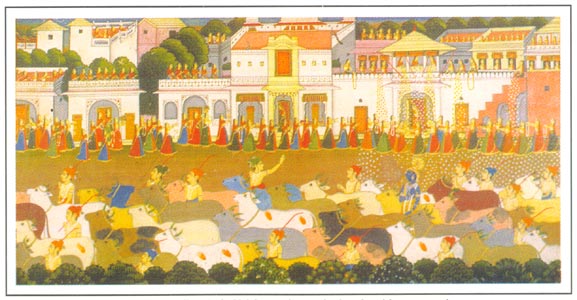 |
|
After the Govardhan Puja Krishna going to the jungle with gopas and cows, Jaipur, circa 1750-1800 A.D., National Museum, New Delhi |
Alwar, a sub-centre of Jaipur, excelled in fine compositions, mystic feminine beauty, variety of themes and graceful figures. Amer preferred representations of abstract themes. Ajmer Sawar went for hunting scenes rendered vigorously. Jalor; Jaisalmer and Pushkar confined their art activity to frescoes.
Dr. Daljeet, Dr. V. K. Mathur & Rajeshwari Shah
(Source: Gallery Sheets of Indian Miniature paintings published by the National Museum. New Delhi)
|
|